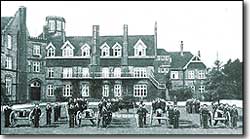|
/back
Watts Naval School
 They
came from all over Britain. Young boys, a bag of belongings in their hands
and who knows what feelings in their hearts as they stepped off the train
at the quaint little County School station. They
came from all over Britain. Young boys, a bag of belongings in their hands
and who knows what feelings in their hearts as they stepped off the train
at the quaint little County School station.
As their eyes and lungs took in the pretty Norfolk countryside air around
them, a military voice would bark in their direction: “Over ’ere, you lot!
Fall in, two ranks, right turn. Quick march... left, right, left, right.”
Ahead was a tree-lined drive that marched them straight up to an
impressive brick and flint school building which would be their home for
the next five years.
These were the first sights and sounds for most of the boys of Watts Naval
Training School at North Elmham, in the first half of the 1900s.
The story of the school began in 1873 when the then Prince of Wales, later
King Edward VII, laid the foundation stone for Norfolk County School on
the outskirts of North Elmham, half way between Dereham and Fakenham.
It began to take in pupils from around the country and indeed abroad, each
paying school fees of 40 guineas. However, the school roll gradually fell
as families found the fees too high. By 1895 it had closed.
Around the corner though was a new life in the hands of the famous Dr
Thomas Barnado. He became interested in the school when it came up for
sale.
He visited the place, travelling – just like the pupils – up by train to
the County School railway station that had been built to serve it.
Dr Barnado loved the place and wanted to buy, but money was scarce. Just
when it seemed all hope was lost, an answer came in the form of wealthy
ship owner Edmund Watts.
Watts agreed to buy and pay for the conversion of the school, with its 54
acres. And when Edmund Watts passed on, his son Sir Fenwick Watts
continued the family’s generosity.
Before long, the training school had become virtually a self-contained
village. It had its own gym, laundry, drill hall, chapel, cemetery, games
room, playing field, sanatorium, dormitories, water tower, staff houses
and even a cinema.
And so, 101 years ago, Watts Naval School officially opened its doors and
the boys began to arrive.
This time they were not the sons of high fee-paying families. The pupils
now had been specially selected from various homes and foster homes run by
Dr Barnardo around the country.
But whether the boys felt they were privileged or being punished by this
selection is open to debate. Certainly, the schooling they were about to
undertake was no easy ride.
This was a military-style life and training. The boys were given numbers
to identify themselves more so than their own names. Their hair was
clipped short and they were rigged out in sailors’ uniforms.
In a strict regime which seems terribly harsh by today’s standards, the
boys’ lives were now to be governed by bugle calls. The cane was used as a
swift punishment for those breaking the rules.
The boys’ best kit was stowed away, and their boots and socks were locked
up. Apart from on Sunday parades and for church services, they would wear
nothing on their feet inside or outside the building from April to October
– regardless of the weather!
Their days began at 5.45am. The first hour of the day was reserved for
cleaning, sweeping, scrubbing and polishing.
Next would come breakfast and then assembly. Classes began at 9.15am and
would continue through the day till 4.50pm. The boys would learn
seamanship, physical training, gunnery, drill and signals, as well as
other lessons.
The evenings were busy too – tea, homework, supper and, at 8pm, the
teeth-cleaning ceremony when hundreds of boys lined up for a spoonful of
cooking salt with which to scrub and gargle.
After another assembly, it was time for prayers and lights out at 9pm.
Throughout the night, boys would take turns at sentry duty.
It was a tough life and one which hit hard during those first few weeks,
but the reports seem to indicate that most boys grew to love their unusual
school in the end.
Watts Naval School prided itself on turning out many a fine young sailor
to serve the country during the period covering the two world wars.
It continued as a Barnado home until 1953, although many of the boys and
staff transferred four years earlier to Dorset at what became the
Parkstone Nautical Training School.
East Anglian Regional Hospital Board intended to buy the buildings and
convert them into a hospital for the treatment of mental illness.
But there was a loud outcry from nearby residents who tried to stop the
plans.
They invoked a restrictive clause in the original deeds and the resulting
legal wrangle continued until 1955, when it was finally announced that a
London demolition contractors company had bought the property.
The school buildings fell in and out of the news amid stories of them
being destined to become a centre for Hungarian refugees or an old
people’s home.
But eventually, in 1960, the place was sold to an Exeter estate developer
who split up the property into lots to be sold off.
And so they remain today.
The main school building has long gone and a selection of houses are
around the site.
But for those who learned their skills of seamanship and who grew up in
its strict environment, this will forever be the Watts Naval School.
> visit the Watts Naval Training School web site
|